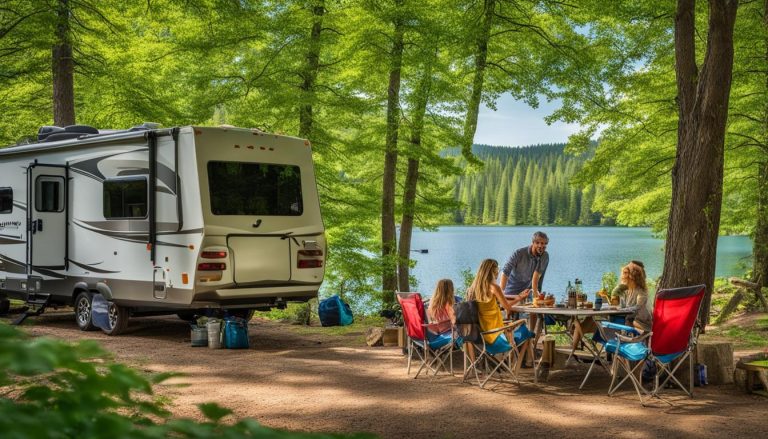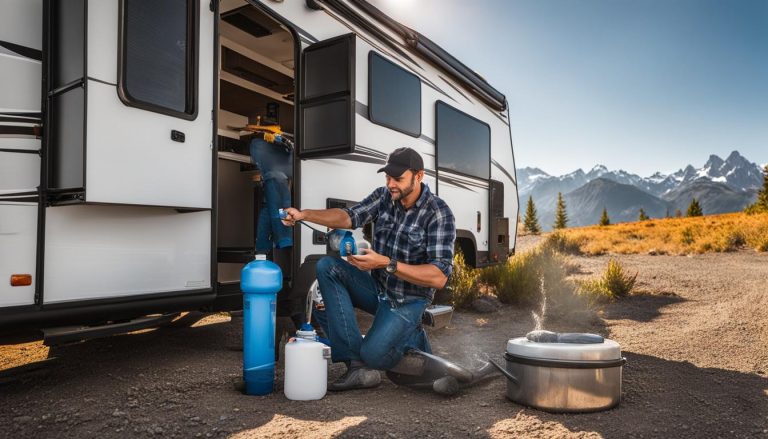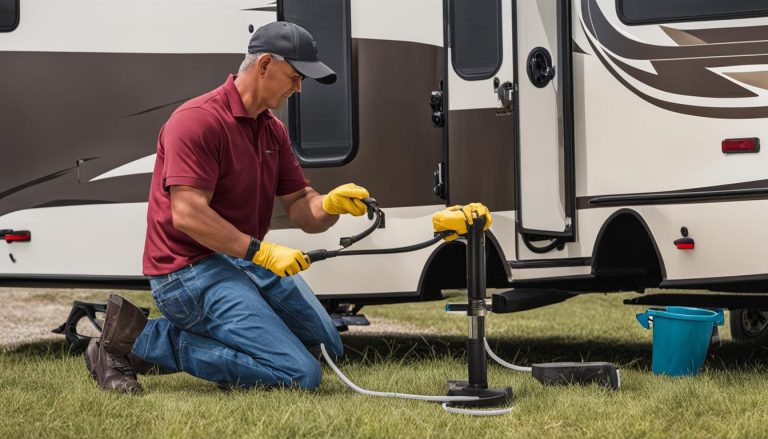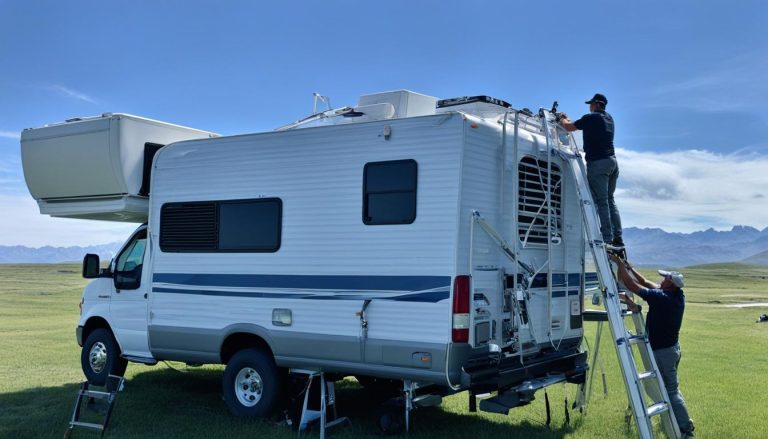Keep Moisture Out of RV in Storage – Top Tips
gorvlifestyle.com and its partners may earn a commission if you purchase a product through one of our links
If you’re planning on long-term RV storage, it’s important to know how to prevent mold and moisture buildup. Mold can be caused by trapped moisture in closed-up RVs, so taking preventive measures is crucial. Inspect your RV for any damage or moisture presence before storage. Use a dehumidifier to remove excess moisture from the air. Consider renting an indoor storage unit to protect your RV from rain and condensation. Blow out fresh water lines to prevent any leftover water from causing mold growth. Use desiccants to absorb moisture in the RV. Cover your RV with a specialized RV cover that is waterproof and allows for ventilation. Remove fabrics and open closets, cupboards, windows, and roof vents to promote airflow. Wipe down all surfaces to remove any moisture or condensation. Inspect for any leaks or cracks that could let moisture in. Run a heater and a fan to further reduce moisture. Finally, inspect your RV regularly for any signs of moisture or mold and treat them immediately.
Key Takeaways:
- Inspect your RV for damage and moisture before storage.
- Use a dehumidifier to remove excess moisture from the air.
- Rent an indoor storage unit if possible to protect from rain and condensation.
- Blow out fresh water lines to prevent mold growth.
- Use desiccants and a waterproof RV cover to absorb moisture and promote ventilation.
How Does Mold Form in RVs?
Mold can form in RVs due to the presence of mold spores, which are naturally present in the environment. RVs can be especially prone to mold growth because they are often closed up and stored for long periods of time, creating a moist and dark environment that is conducive to mold growth.
Mold spores can find a moist place to grow inside the RV and feed on the trapped moisture, leading to mold formation. The musty smell often indicates the presence of mold. Mold growth can cause respiratory issues and should be addressed promptly to prevent further damage.
Moisture plays a crucial role in mold formation in RVs. When moisture is present, whether from leaks, condensation, or high humidity, it provides the ideal conditions for mold spores to germinate and grow. Mold thrives in damp environments with poor ventilation, making RVs a prime breeding ground.
To better understand the causes of mold growth in RVs, let’s take a look at the factors that contribute to moisture buildup:
- Poor sealing: Leaks or gaps in the RV’s exterior can allow water to seep in, leading to moisture accumulation.
- Condensation: Temperature differences between the interior and exterior of the RV can cause condensation to form on windows, walls, and other surfaces, creating a moist environment.
- Inadequate ventilation: Lack of proper airflow can trap moisture inside the RV, promoting mold growth.
- Water damage: Water leaks from plumbing, appliances, or exterior sources can infiltrate the RV and create a breeding ground for mold.
- Poor maintenance: Neglecting regular inspections and maintenance can lead to unidentified leaks or other issues that contribute to mold growth.
To prevent mold formation in your RV, it is essential to address these moisture-related factors:
- Inspect for leaks and seal any openings: Regularly examine your RV for any signs of leaks, cracks, or gaps in the exterior. Repair and seal them promptly to prevent water intrusion.
- Control indoor humidity: Use a dehumidifier to remove excess moisture from the air inside the RV. Keep the humidity level between 30% and 50% to discourage mold growth.
- Improve ventilation: Open windows, cabinets, and roof vents to promote airflow and reduce moisture buildup. Consider installing vent fans in the bathroom and kitchen areas of your RV.
- Address water damage: Repair any plumbing or appliance leaks immediately. Dry and clean up any water spills or accidents promptly to prevent moisture from seeping into the RV’s structure.
- Regularly clean and maintain: Regularly clean and inspect your RV for signs of mold or any moisture-related issues. Promptly address any mold growth or water intrusion to prevent further damage.
By understanding how mold forms in RVs and taking preventive measures, you can ensure a mold-free and healthy environment in your RV.
How to Keep Mold Out of Your Camper During Storage
To prevent mold in RV storage, it’s crucial to minimize dampness and promote airflow. Taking the right steps before storing your RV can help protect it from moisture and mold growth. Follow these mold prevention tips to keep your camper dry and mold-free during storage:
- Inspect for Damage: Thoroughly inspect your RV for any signs of damage or moisture presence. Address any issues identified before storing.
- Use a Dehumidifier: Remove moisture from the air inside your RV by using a dehumidifier. Run it for a few hours or days before storage, keeping the RV closed during this period. If your storage spot has an electrical hookup, consider using a small dehumidifier.
- Rent an Indoor Storage Unit: If possible, rent an indoor storage unit to protect your RV from moisture, rain, and condensation. This is especially important for winter storage.
- Blow Out Fresh Water Lines: Before storage, blow out the fresh water lines to prevent any remaining water from causing mold growth.
- Use Desiccants: Place desiccants designed for RVs inside your camper to absorb moisture throughout the storage period.
- Invest in a Proper RV Cover: If indoor storage isn’t possible, invest in a waterproof RV cover that allows for ventilation. This will protect your RV from rain and snow while still allowing airflow.
- Promote Airflow: Open windows, closets, cupboards, and roof vents to promote airflow inside the RV. Remove fabrics that can trap moisture.
- Wipe Down Surfaces: Before storage, wipe down all surfaces inside the RV to remove any moisture or condensation.
- Inspect for Leaks and Cracks: Regularly inspect your RV for any leaks or cracks that could let moisture in. Address them promptly to prevent mold growth.
- Reduce Moisture: Run a heater and a fan inside the RV to further reduce moisture levels.
- Regular Inspections: Inspect your camper at least once a month during storage to check for any signs of moisture or mold. If you notice any issues, treat them immediately to prevent further damage.
By following these mold prevention tips for RV storage, you can keep your camper in good condition and enjoy worry-free adventures when it’s time to hit the road again.
Cleaning and Maintenance Tips for RV Storage
Properly cleaning and maintaining your RV before storage is essential to prevent the growth of mold and the accumulation of moisture. By following these tips, you can ensure that your RV remains in optimal condition and ready for your next adventure.
Thorough Cleaning
Before storing your RV, take the time to thoroughly clean both the interior and exterior. Remove all food and water from the vehicle and empty and clean all holding tanks. Wipe down all work surfaces with antibacterial wipes or sprays, paying special attention to cabinets and closets where moisture can accumulate. This will help eliminate any potential sources of mold and reduce the risk of moisture buildup.
Reduce Moisture and Humidity
Moisture and humidity can contribute to mold growth and damage in your RV during storage. After cleaning, thoroughly dry every surface in your RV, including carpets, upholstery, and bedding. Check for any leaky pipes or signs of standing water that could introduce moisture. Running a dehumidifier in your RV while it’s in storage can also help control moisture levels and reduce the risk of mold.
Regular Inspection and Maintenance
Regularly inspect your RV for any maintenance issues or potential sources of moisture. Check for leaks, cracks, or damaged seals that could lead to water intrusion. Address any issues promptly to prevent further damage. It’s also important to keep track of all your RV maintenance and repairs to ensure timely and proper upkeep of your vehicle.
Cleaning and Maintenance Checklist
| Task | Frequency |
|---|---|
| Remove all food and water | Before storage |
| Empty and clean holding tanks | Before storage |
| Wipe down work surfaces | Before storage |
| Dry every surface | Before storage |
| Check for leaks and cracks | Regularly |
| Run dehumidifier | During storage |
By following these cleaning and maintenance tips, you can ensure that your RV is well-maintained and protected against moisture and mold during storage. Regular inspections and proper upkeep will help preserve the condition of your RV and ensure many enjoyable road trips to come.
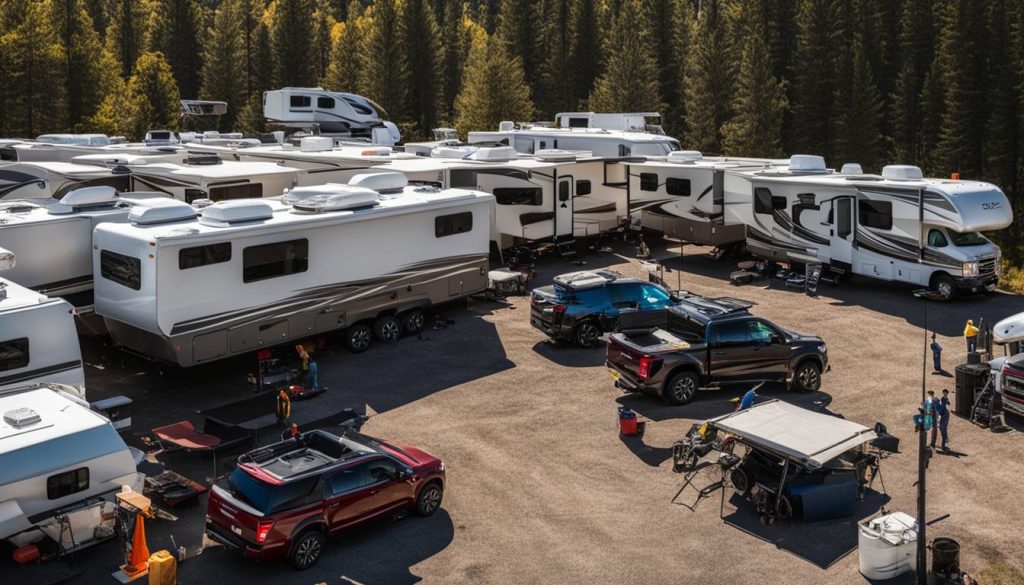
Challenges of Storing RVs in Humid Climate
Storing your RV in a humid climate can pose unique challenges when it comes to preventing mold growth and moisture buildup. Areas with high humidity, such as coastal regions, create a naturally damp environment that increases the risk of mold and moisture-related issues.
To protect your RV from these challenges, it is essential to take extra precautions to minimize moisture and promote airflow. Here are some tips:
- Use dehumidifiers: Invest in high-quality dehumidifiers to remove excess moisture from the air inside your RV. This will help prevent mold growth and keep the interior dry.
- Ensure proper ventilation: Proper airflow is crucial for preventing moisture buildup. Open windows, vents, and roof vents to promote air circulation. Consider using RV vent covers to allow for ventilation even when it’s raining.
- Regular inspections: Conduct routine inspections to detect any signs of moisture or mold. Check for leaks, cracks, or any areas where water could enter your RV. Address any issues promptly to prevent further damage.
By implementing these measures, you can protect your RV from the challenges of storing it in a humid climate and ensure that it stays in optimal condition for your next adventure.
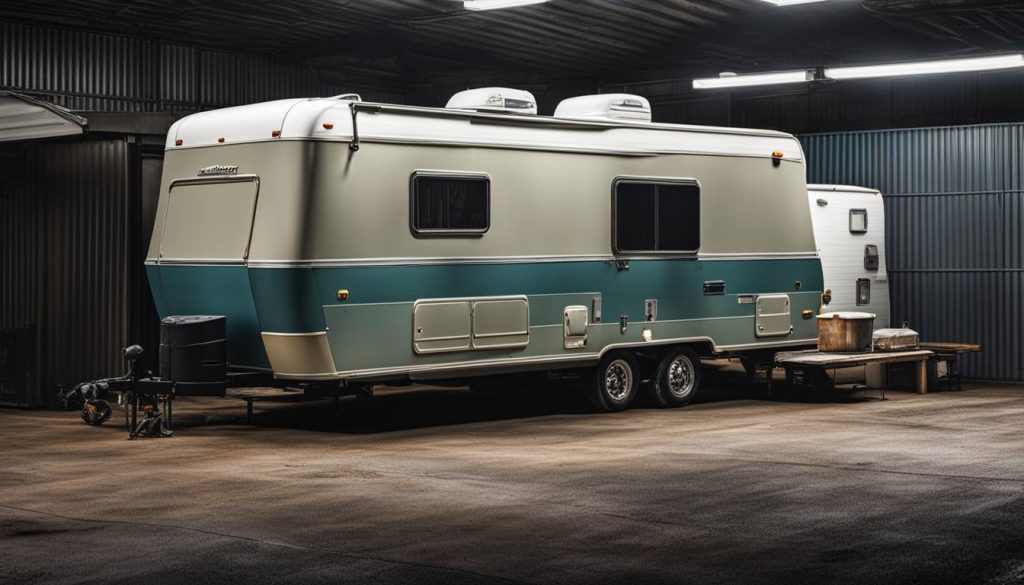
| Challenges | Solutions |
|---|---|
| Increased risk of mold growth | Use dehumidifiers, ensure proper ventilation, and conduct regular inspections to prevent mold. |
| Excess moisture buildup | Invest in dehumidifiers, promote airflow, and address leaks or cracks promptly. |
| Potential damage to the RV’s interior | Regular inspections and maintenance will help detect and prevent any damage caused by moisture. |
By addressing the challenges of storing RVs in humid climates, you can enjoy peace of mind knowing that your RV is protected and ready for your next journey.
The Importance of Regular Inspections and Prompt Action
Regular inspections of your RV, at least once a month, are crucial to detect and address any signs of moisture or mold growth. By staying vigilant and conducting thorough inspections, you can identify and tackle potential issues before they escalate. Inspect your RV for any leaks, cracks, or other potential entry points for moisture that can lead to mold formation. Pay attention to musty smells, discoloration, bubbling, or rust spots as they may indicate the presence of mold.
Addressing any moisture or mold issues promptly is essential to prevent the spread of mold and mitigate the risk of extensive damage. Mold can quickly grow and spread, causing structural damage, health hazards, and costly repairs if left untreated. Treating mold early on not only ensures the well-being of your RV but also helps minimize the effort and cost involved in the removal process.
By prioritizing regular inspections and taking immediate action, you can effectively prevent extensive mold damage and maintain the overall condition of your RV during storage. Remember, prevention is key when it comes to mold growth. Stay proactive, be attentive to any signs of moisture or mold, and take prompt action to ensure that your RV remains in optimal shape for your next adventure.
FAQ
How do I keep moisture out of my RV during storage?
To keep moisture out of your RV during storage, you can take several preventive measures. These include inspecting your RV for any damage or moisture presence before storage, using a dehumidifier to remove excess moisture from the air, considering renting an indoor storage unit to protect your RV from rain and condensation, blowing out fresh water lines, using desiccants to absorb moisture, covering your RV with a specialized RV cover, removing fabrics and opening closets, cupboards, windows, and roof vents to promote airflow, and running a heater and a fan to further reduce moisture.
How does mold form in RVs?
Mold forms in RVs due to the presence of mold spores, which are naturally present in the environment. RVs can be prone to mold growth because they are often closed up and stored for long periods of time, creating a moist and dark environment that is conducive to mold growth. Mold spores find a moist place to grow inside the RV and feed on the trapped moisture, leading to mold formation. The musty smell is often a sign of mold presence, and it can cause respiratory issues.
How can I prevent mold in my camper during storage?
To prevent mold in your camper during storage, you can take several steps. These include minimizing dampness and promoting airflow by inspecting your RV for any damage or presence of moisture, using a dehumidifier to remove moisture from the air, renting an indoor storage unit if possible, blowing out fresh water lines, using desiccants to absorb moisture, using a proper RV cover that is waterproof and allows for ventilation, removing fabrics and opening windows, closets, cupboards, and roof vents, wiping down all surfaces to remove moisture or condensation, inspecting for leaks or cracks, running a heater and a fan, and regularly inspecting your RV for signs of moisture or mold.
How should I clean and maintain my RV before storage?
Cleaning and maintaining your RV before storage is essential to prevent mold growth and moisture buildup. Remove all food and water from the vehicle, empty and clean all holding tanks, wipe down all work surfaces with antibacterial wipes or sprays, thoroughly dry every surface, check for leaky pipes or signs of standing water, run a dehumidifier, and regularly inspect your RV for any maintenance issues or leaks that could lead to mold growth.
What are the challenges of storing RVs in a humid climate?
Storing RVs in a humid climate presents unique challenges when it comes to preventing mold growth and moisture buildup. In areas with high humidity, such as coastal regions, the risk of mold and moisture-related issues is higher due to the naturally moist environment. Extra precautions to minimize moisture and promote airflow are necessary. Regular inspections and maintenance are essential to detect and address any signs of mold or moisture promptly.
Why are regular inspections and prompt action important for preventing mold in RVs?
Regular inspections of your RV are crucial to detect and address any signs of moisture or mold growth. Inspecting for leaks, cracks, and other potential entry points for moisture is essential. Musty smells, discoloration, bubbling, or rust spots could indicate mold presence. By addressing issues promptly, you can prevent mold from spreading and causing extensive damage. Treating mold early on minimizes the effort and cost of removal. Taking these preventive measures and treating mold immediately will help ensure that your RV remains in good condition during storage and is ready for your next adventure.

